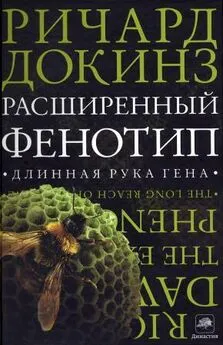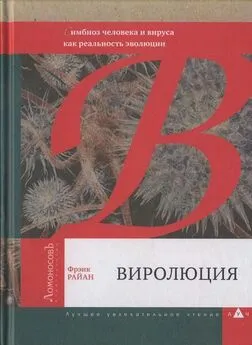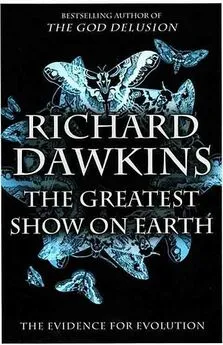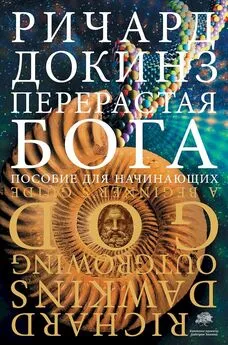Ричард Докинз - Расширенный Фенотип: длинная рука гена
- Название:Расширенный Фенотип: длинная рука гена
- Автор:
- Жанр:
- Издательство:Астрель
- Год:2010
- Город:Москва
- ISBN:978-5-271-31206-9
- Рейтинг:
- Избранное:Добавить в избранное
-
Отзывы:
-
Ваша оценка:
Ричард Докинз - Расширенный Фенотип: длинная рука гена краткое содержание
Richard Dawkins, 1982,1999 Afterword ©
Фенотип — совокупность характеристик, присущих индивиду на определённой стадии развития. Фенотип также можно определить как «вынос» генетической информации навстречу факторам среды.
Расширенный фенотип — это все воздействия, оказываемые геном на мир. Например, согласно Ричарду Докинзу, плотину бобров также как и их резцы можно считать фенотипом генов бобра. Psychedelic.
Расширенный Фенотип: длинная рука гена - читать онлайн бесплатно ознакомительный отрывок
Интервал:
Закладка:
Thoday,J. M. (1953). Components of fitness. Society for Experimental Biology Symposium 7, 96-113.
Thomas,L. (1974). The Lives of a Cell. London: Futura.
Thompson, DA. W. (1917). On Growth and Form. Cambridge: Cambridge University Press.
Tinbergen, N. (1954). The origin and evolution of courtship and threat display. In Evolution as a Process (eds J. S. Huxley, A. C. Hardy & E. B. Ford), pp.233–250. London: Allen & Unwin.
Tinbergen,N. (1963). On aims and methods of ethology. Zeitschrift fur Tierpsychologie 20, 410–433.
Tinbergen,N. (1964). The evolution of signaling devices, in Social Behavior and Organization among Vertebrates (ed.W. Etkin),pp. 206–230. Chicago: Chicago University Press.
Tinbergen,N. (1965). Behaviour and natural selection. In Ideas in Modern Biology (ed.J. A. Moore),pp. 519–542. New York: Natural History Press. Tinbergen,N., Broekhuysen, G.J., Feekes, F., Houghton,J. G. W., Kruuk,H. & Szulc,E. (1962). Egg shell removal by the black-headed gull, Lams ridibundus , L.; a behaviour component of camouflage. Behaviour 19, 74-117. Trevor-Roper,H. R. (1972). The Last Days of Hitler. London: Pan. Trivers,R. L. (1971). The evolution of reciprocal altruism. Quarterly Review of Biology 46, 35–57.
Trivers,R. L. (1972). Parental investment and sexual selection. In Sexual Selection and the Descent of Man (ed.B. Campbell),pp. 136–179. Chicago: Aldine.
Trivers,R. L. (1974). Parent-offspring conflict. American Zoologist 14, 249–264.
Trivers,R. L. & Hare,H. (1976). Haplodiploidy and the evolution of the social insects. Science 191, 249–263.
Turing,A. (1950). Computing machinery and intelligence. Mind 59, 433–460. Turnbull,C. (1961). The Forest People. London: Cape.
Turner, J. R. G. (1977). Butterfly mimicry: the genetical evolution of an adaptation. In Evolutionary Biology , Vol.10 (edsM. K. Hecht et al.), pp.163–206. New York: Plenum Press.
Vermeij, G. J. (1973). Adaptation, versatility and evolution. Systematic Zoology 22, 466–477.
Vidal,G. (1955). Messiah. London: Heinemann.
Waddington,C. H. (1957). The Strategy of the Genes. London: Allen & Unwin.
Wade,M. J. (1978). A critical review of the models of group selection. Quarterly Review of Biology 53,101–114.
Waldman,B. & Adler,K. (1979). Toad tadpoles associate preferentially with siblings. Nature 282, 611–613.
Wallace,A. R. (1866).Letter to Charles Darwin dated 2July. In J. Marchant (1916) Alfred Russel Wallace Letters and Reminiscences , Vol. 1,pp. 170–174.London: Cassell.
Watson,J. D. (1976). Molecular Biology of the Gene. Menlo Park: Benjamin. Weinrich,J. D. (1976). Human reproductive strategy: the importance of income unpredictability, and the evolution of non-reproduction. PhD dissertation, Harvard University, Cambridge, Mass.
Weizenbaum,J. (1976). Computer Power and Human Reason. San Francisco: W H. Freeman.
Wenner,A. M. (1971). The Bee Language Controversy: An Experience in Science. Boulder: Educational Programs Improvement Corporation.
Werren,J. H., Skinner,S. K. & Charnov,E. L. (1981). Paternal inheritance of a daughterless sex ratio factor. Nature 293, 467–468. West-Eberhard,M. J. (1975). The evolution of social behavior by kin selection. Quarterly Review of Biology 50, 1-33.
West-Eberhard, M. J. (1979). Sexual selection, social competition, and evolution. Proceedings of the American Philosophical Society 123, 222–234.
White,M. J. D. (1978). Modes of Speciahon. San Francisco: W H. Freeman. Whittiam,T. G. & Slobodchikoff,C. N. (1981). Evolution of individuals, plant-herbivore interactions, and mosaics of genetic variability: the adaptive significance of somatic mutations in plants. Oecologia. 49, 287–292.
Whitney,G. (1976). Genetic substrates for the initial evolution of human sociality. I. Sex chromosome mechanisms. American Naturalist 110, 867–875. Wickler,W. (1968). Mimicry. London: Weidenfeid & Nicolson.
Wickler,W. (1976). Evolution-oriented ethology, kin selection, and altruistic parasites, Zeitschrift fur Tierpsychologie 42, 206–214.
Wickler,W. (1977). Sex-linked altruism, Zeitschrift fur Tierpsychologie 43, 106–107.
Williams, G. C. (1957). Pleiotropy, natural selection, and the evolution of senescence. Evolution 11, 398–411.
Williams,G. C. (1966). Adaptation and Natural Selection. Princeton, N.J.: Princeton University Press.
Williams,G. C. (1975). Sex and Evolution. Princeton, N.J.: Princeton University Press.
Williams,G. C. (1979). The question of adaptive sex ratio in outcrossed vertebrates. Proceedings of the Royal Society of London , В 205, 567–580.
Williams,G. C. (1980). Kin selection and the paradox of sexuality. In Sociohiology: Beyond Nature/Nurture? (edsG. W. Barlow& J. Silverberg),pp. 371–384. Boulder: Westview Press.
Wilson,D. S. (1980). The Natural Selection of Populations and Communities. Menlo Park: Benjamin/Cummings.
Wilson,E. O. (1971). The Insect Societies. Cambridge, Mass.: Harvard University Press.
Wilson,E. O. (1975). Sociohiology: the New Synthesis. Cambridge, Mass.: Harvard University Press.
Wilson,E. O. (1978). On Human Nature. Cambridge, Mass.: Harvard University Press.
WiNOGRAD,T. (1972). Understanding Natural Language. Edinburgh: Edinburgh University Press.
Witt, P.N., Reed,C. F. & Peakall,D. B. (1968). A Spider's Web. New York: Springer Verlag.
Wolpert,L. (1970). Positional information and pattern formation, in Towards a Theoretical Biology , 3: Drafts (ed.C. H. Waddington),pp. 198–230. Edinburgh: Edinburgh University Press.
Wright,S. (1932).The roles of mutation, inbreeding, crossbreeding and selection in evolution. Proceedings of the 6th International Congress of Genetics 1, 356–368.
Wright,S. (1951).Fisher and Ford on the Sewall Wright effect. American Science Monthly 39, 452–458.
Wright,S. (1980). Genie and organismic selection. Evolution 34, 825–843. Wu, H. M. H., Holmes,W. G., Medina,S. R. & Sackett,G. P. (1980). Kin preference in infant Macaca nemestnna. Nature 285, 225–227. Wynne-Edwards,V. C. (1962). Animal Dispersion in Relation to Social Behaviour. Edinburgh: Oliver & Boyd.
Young,J. Z. (1957). The Life of Mammals. Oxford: Oxford University Press. Young,R. M. (1971). Darwin’s metaphor: does nature select? The Monist 55, 442-503
Z AH AVI,A. (1979). Parasitism and nest predation in parasitic cuckoos. American Naturalist 113,157–159.
Список рекомендуемой литературы
Allaby,М. (1982 ). Animal Artisans. London: Weidenfeld & Nicolson.
Barkow,J. H., Cosmldes,L. & Tooby,J. (1992). The Adapted Mind. New York: Oxford University Press.
Basalla,G. (1988). The Evolution of Technology. Cambridge: Cambridge University Press.
Blackmore,S. (1999). The Meme Machine. Oxford: Oxford University Press. Bonner,J. T. (1988). The Evolution of Complexity. Princeton: N.J.: Princeton University Press.
Brandon,R. N. (1990). Adaptation and Environment. Princeton, N.J.: Princeton University Press.
Brandon,R. N. & Burian,R. M. (1984). Genes, Organisms, Populations: Controversies over the Units of Selection. Cambridge, Mass.: MIT Press.
Buss, L. W. (1987). The Evolution of Individuality. Princeton, N J.: Princeton University Press.
Clayton,D. & Harvey,P. (1993). Hanging nests on a phylogenetic tree. Current Biology 3, 882–883.
Cronin, H. (1991). The Ant and the Peacock. Cambridge: Cambridge University Press.
Cziko,G. (1995). Without Miracles. Cambridge, Mass.: MIT Press.
Davies,N. B. (1992). Dunnock Behaviour and Social Evolution. Oxford: Oxford University Press.
Davis,B. D. (1986). Storm over Biology. Buffalo: Prometheus Books. Dawkins,R. (1982). Universal Darwinism. In Evolution from Molecules to Mm (ed.D. S. Bendall),pp. 403–425. Cambridge: Cambridge University Press. Dawkins,R. (1985). Review of Mot in our Genes (S. Rose,L. J. Kamin& R. C. Lewontin).New Scientist 105,59–60.
Dawkins,R. (1987). Universal parasitism and the extended phenotype. In Evolution and Coadaptation in Biotic Communities (EDSS. Kawano,J. H. Connell& T. Hidaka),pp. 183–197. Tokyo: University of Tokyo Press.
Dawkins,R. (1989a). The evolution of evolvability. In Artificial Life (ed.C. Langton).Santa Fe, N.M.: Addison Wesley.
Dawkins,R. (1989). The Selfish Gene , 2nd edn. Oxford: Oxford University Press. Dawkins,R. (1990). Parasites, desiderata lists, and the paradox of the organism. In The Evolutionary Biology of Parasitism (edsA. E. Keymer& A. F. Read).Cambridge: Cambridge University Press.
Dawkins, R. (1991).Darwin triumphant: Darwinism as a universal truth. In Man and Beast Revisited (edsM. H. Robinson& L. Tiger),pp. 23–39.Washington: Smithsonian Institution.
Dawkins,R. (1996). Climbing Mount Improbable. New York: Norton. Dawkins,R. (1998). Unweaving the Rainbow. London: Penguin.
Читать дальшеИнтервал:
Закладка:







